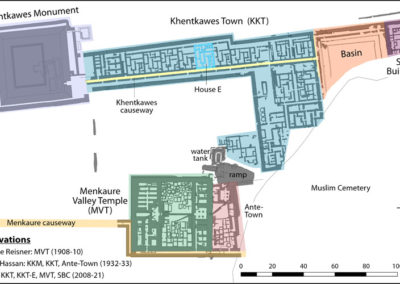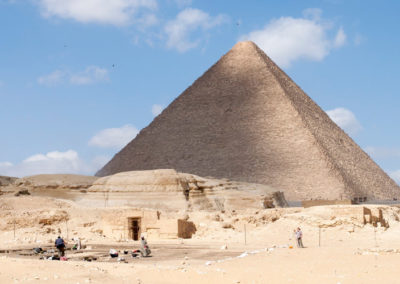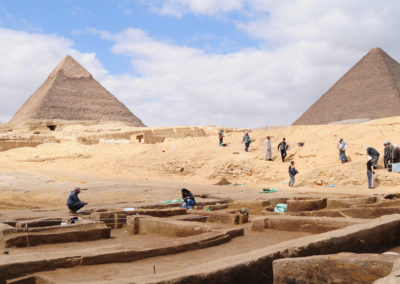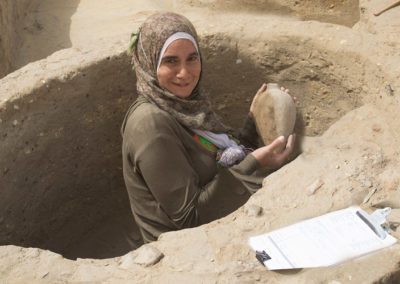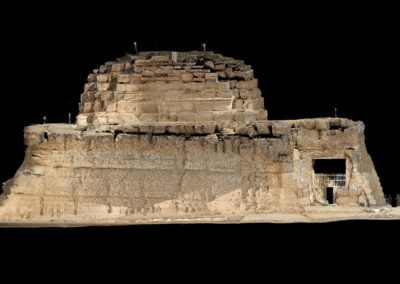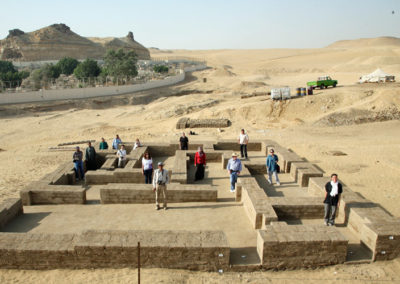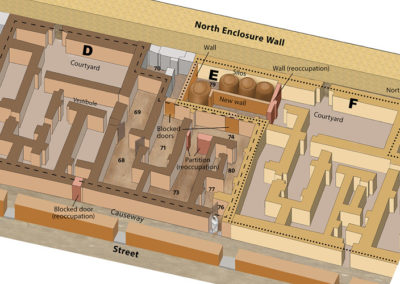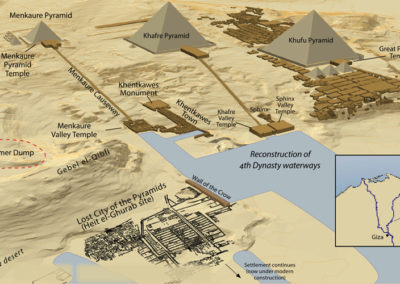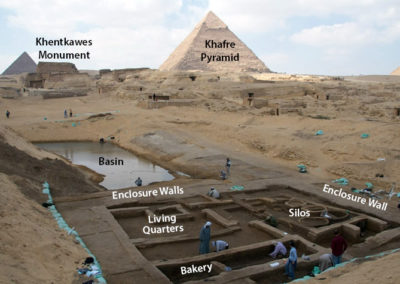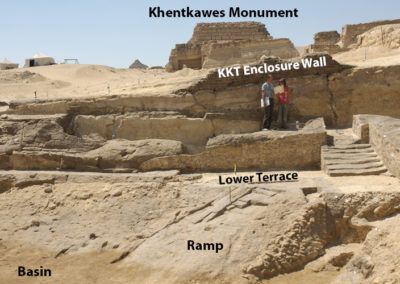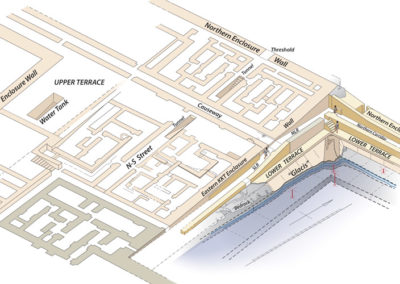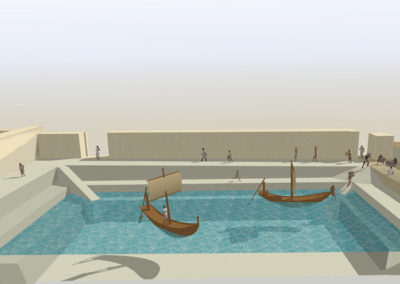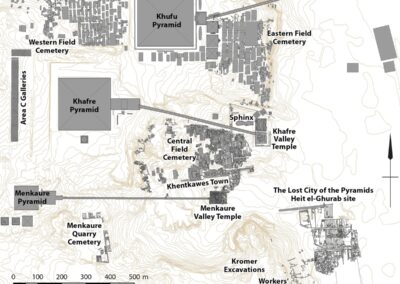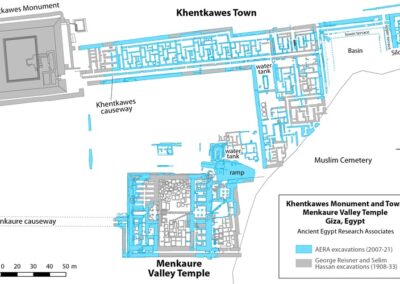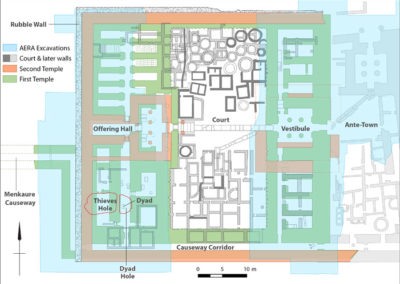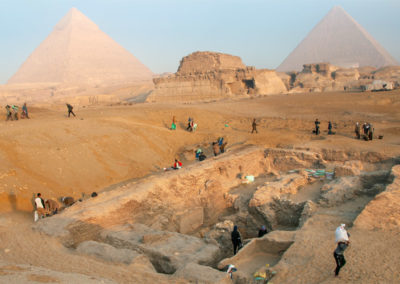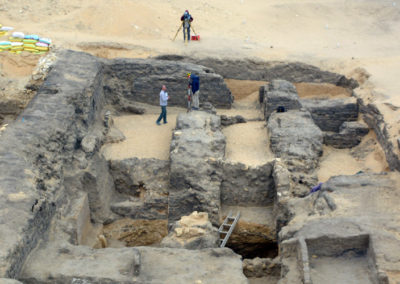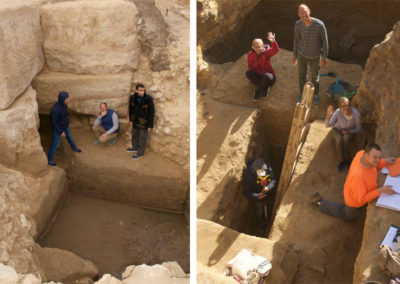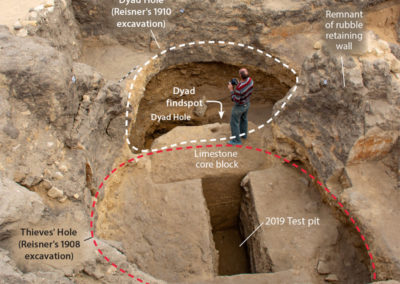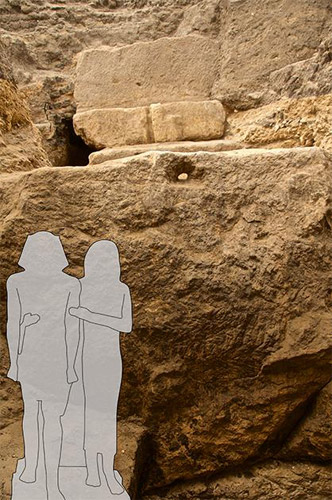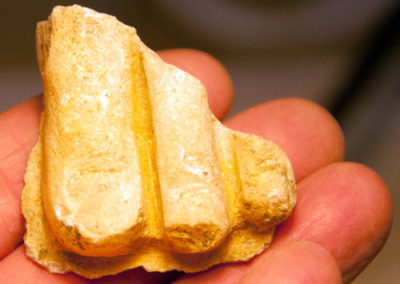Khentkawes Town and the Menkaure Valley Temple
Era
4th-6th Dynasty, Old Kingdom
Location
Giza Plateau
Project Dates
2005 – present
Previous Excavators
George Reisner (1908-1910), Selim Hassan (1932-1933)
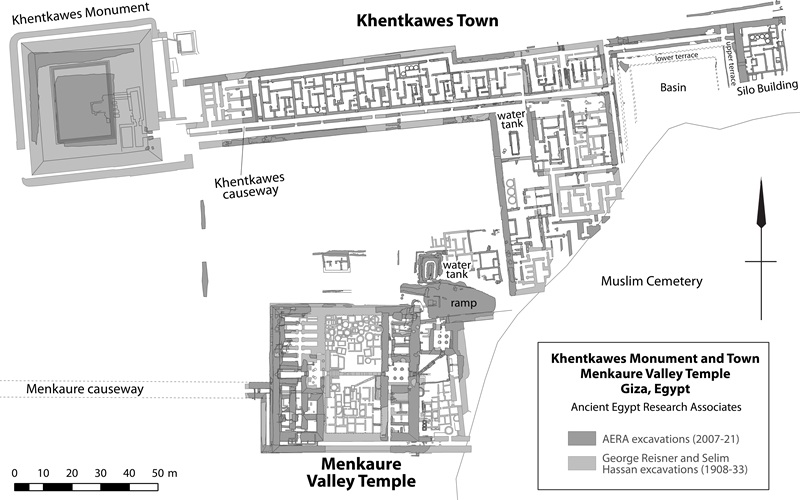
Khentkawes Town and the Menkaure Valley Temple
The Khentkawes Town (KKT) and Menkaure Valley Temple (MVT) sites are crucial to our understanding of the overall settlement of the Giza Plateau. We believe that around the same time people abandoned the Lost City of the Pyramids (Heit el-Ghurab) settlement, they began settling near these two sites. The nature of the settlements on the Giza Plateau then changed from housing the infrastructure that supported the building of large royal monuments into service centers for the cults of the deceased kings.
The Menkaure Valley Temple (MVT)
The Menkaure Valley Temple stands at the end of a long causeway 600 meters east of Menkaure’s pyramid. Following Menkaure’s premature death, his successor, Shepseskaf, completed the temple in mudbrick. Through much of the 5th Dynasty priests carried on rituals there to maintain Menkaure in the Afterlife, but eventually flash floods drove them out and opened the temple to looting.
In the 6th Dynasty, probably under king Pepi II, a new Second Temple was built atop the ruins of the First Temple to re-endow Menkaure’s cult. The outer wall of the Second Temple was built roughly over what survived of the outer wall of the First Temple. Later in the occupation of the Second Temple, a fieldstone “Water Wall” was built against the base of the outer wall as protection against further flash floods. Inside the temple courtyard and to the east of the temple, a mudbrick village spouted, probably populated by servants representing high officials. Toward the end of the 6th Dynasty this Second Temple was also abandoned, probably related to the transition to a drier climate.
When George Reisner first excavated the temple in 1908, he made many amazing discoveries including the world famous Menkaure dyad statue now housed at the Museum of Fine Arts Boston. However, he worked on the excavations piecemeal and never saw the entire temple exposed in phase, so his plan of the temple is reconstructed from separate exposures. After his excavations ended in 1910, the temple remained untouched for nearly 100 years. In 2005 we began re-excavating the MVT to better understand how this temple was built and functioned over its lifespan.
Reisner discovered two periods of occupation at the MVT. The first period ended with a devastating flood that left the First Temple in ruins. The second period saw a new Second Temple built atop the ruins of the old one. However, we discovered there were actually three occupation phases at the temple. After the First Temple was built (phase 1), an earlier previously unknown flood left the First Temple abandoned and open to looting. This first flood damage was eventually repaired and the First Temple was reoccupied (phase 2) until a second flash flood—the one Reisner found evidence of—led to the abandonment of the First Temple and the eventual building of the Second Temple (phase 3).
We also discovered a rich trove of material culture in the excavation spoils that Reisner’s workman dumped. Recovered through dry- and wet-sieving and meticulous sorting, much of this material came from the mudbrick settlement that had grown up in the central court during the 5th and 6th Dynasties. This material is still being studied, but the animal bone remains have already yielded an important discovery. The bones are predominantly fragments of cattle longbones. And they help answer a perplexing question: were the pekher offerings, promised in the royal decrees of Shepseskaf (Menkaure’s successor) and Pepi II to maintain Menkaure, real or symbolic? The cattle bones appear to be the remains of actual pekher that were offered to the deceased Menkaure and then passed on to the staff sustaining him. They came predominantly from the forelegs, the part that is most frequently shown in tomb scenes as offerings.
We also corrected Reisner’s theory about the famous dyad of Menkaure and a woman, now in the Boston Museum of Fine Art. Reisner discovered it buried in a deep hole in the temple floor and believed that Islamic period robbers had dug the pit and cached the statue planning to return later for it. However, our excavations indicated that the dyad had been buried much earlier, possibly by priests trying to keep it safe from looters.
Khentkawes Town (KKT)
Northwest of the Menkaure Valley Temple, stands the monumental tomb of Queen Khentkawes I, an enigmatic 4th Dynasty queen who may have ruled as king and been the mother of at least one 5th Dynasty king. Her gigantic mastaba was carved out of a block of limestone bedrock left by workers quarrying stone for the pyramid complexes.
Extending east of her tomb lies the remains of a highly planned settlement built for the priests attending her cult. Built late in the 4th Dynasty, the town was occupied during the 5th Dynasty, then abandoned and reoccupied during the 6th. This area was first excavated by Selim Hassan in 1932.
During our excavations, we’ve found evidence in this area of an occupation phase predating the priests’ town. This early settlement may have been used during the initial construction of the Menkaure Valley Temple.
Khentkawes Valley Complex (KKT-E)
When AERA began excavating at the Khentkawes Town, we discovered a previously unknown extension of the site to the east. We uncovered an enclosure wall and two terraces bounding the north and east sides of a large basin that was part of a system of ancient waterways off the Nile extending to the pyramid complexes. During the inundation, the basin filled with Nile water and allowed transport by boat onto this part of the Giza plateau. On the west side of the basin, ramps and stairs led up to a monumental entrance to the KKT.
Silo Building Complex (SBC)
On the opposite side of the basin from KKT, we discovered the Silo Building Complex in 2011. Walkways along the north side of the basin connected this area to Khentkawes Town.
The compound was the home/office of a high official and included grain silos, a bakery, and probably a brewery. As far as we know, this was the final building phase in the Khentkawes Town area. It was part of a larger complex that continued to the east and south, areas that are inaccessible to excavation.
Khentkawes Town Photogallery
Areas of excavation at the Khentkawes Town (KKT) and Menkaure Valley Temple (MVT) sites. While the KKT and MVT sites were previously known, the Basin and Silo Building Complex were unknown until our excavations.
Excavating at the Khentkawes Town with the pyramids of Khufu (right) and Khafre (left) in the background.
Hanan Mahmoud displays a jar she found at the SBC. Hanan graduated from our field school program and later became an instructor, helping to train her fellow colleagues from the Egyptian Ministry of Tourism and Antiquities.
An orthophotographic point cloud image of the south face of the Queen Khentkawes funerary monument, prepared by the Giza Laser Scanning team in 2006.
A reconstruction of House E, one of the high status “houses” at the Khentkawes Town site. The reconstruction gives a sense of just how large these structures were!
A 3D reconstruction of three houses in the Khentkawes Town site. The size and layout of these modular “houses” reflects the high status of their inhabitants. The spaces were remodeled over the course of their use. As shown here, doorways were blocked off and new walls added.
A reconstruction of the ancient monuments, settlements and waterways of the Giza Plateau during the 4th Dynasty.
The Silo Building Complex excavations during the 2012 field season. Note how the high water table floods the basin at this time.
Looking west from the Basin toward KKT during the 2009 field season. The ramp would have led down from KKT to the basin that connected to a series of flood season waterways and eventually to the main Nile channel.
A 3D reconstruction of the eastern end of the Khentkawes Town where it meets the Basin. From an isometric drawing by Mark Lehner.
Menkaure Valley Temple Photogallery
Reisner’s plan of the First (green) and Second (orange) Menkaure Valley Temples showing the areas of AERA’s excavations (blue).
AERA excavations in progress in the Menkaure Valley Temple , west end, during the 2020 field season. The Khafre (left) and Khufu (right) pyramids stand in the background with the Khentkawes monument between them.
Season 2019 excavations in the Menkaure Valley Temple. During 2019, our fourth season in the MVT, we focused on the southwest area of the temple.
Excavations in the southwest corner of the Menkaure Valley Temple in 2019. Archaeologist Dan Jones photographs the Dyad Hole with the Thieves Hole at his back.
An outline of the Menkaure Dyad statue positioned where we determined that George Reisner originally found it in 1910.
Selected Menkaure Valley Temple Bibliography
2024. Lehner, Mark. “Giza Plateau Mapping Project.” Oriental Institute 2023-2024 Annual Report. Edited by Timothy P. Harrison. Chicago: University of Chicago Oriental Institute. Pages 33-40.
2024. “Field Lab: Old and New.” AERA Annual Report 2023–2024, pages 10-11.
2024. “Fieldwork 2023-2024: Menkaure Valley Temple (MVT).” AERA Annual Report 2023–2024, pages 6-7.
2024. Lehner, Mark. “President’s Message: Foundations from the Past, Building for the Future.” AERA Annual Report 2023–2024, pages 3-4.
2023. Friedman, Florence Dunn. “Evidence for More Statues of Menkaure.” The Overseer of Works in Memphis and Thebes: Studies in Honour of Nigel Strudwick. Edited by M. Pitkin. Liverpool: Abercromby Press. Pages 45–59.
2023. Almansa-Villatoro, M. Victoria, S. Stubnova Nigrelli, and Mark Lehner (editors). In the House of Heqanakht: Text and Context in Ancient Egypt. Studies Presented in Honor of James P. Allen. Leiden/Boston: Brill.
2023. LaPorta, Philip. “From Giza: A Rock Like No Other.” AERAGRAM vol 24 no 1-2, page 32.
2023. “Field Lab Discoveries, Learning, Insights.” AERA Annual Report 2022–2023, pages 12–13.
2022. Friedman, Florence Dunn. “Art and Accounting of the Heb Sed.” AERAGRAM vol 23 no 1-2, pages 18-26.
2022. “Field Work 2021-2022.” AERA Annual Report 2021–2022, pages 6–7.
2022. “AERA Field Lab.” AERA Annual Report 2021–2022, pages 8–9.
2022. Lehner, Mark. “Giza Plateau Mapping Project,” Oriental Institute 2021-2022 Annual Report. Edited by Theo van den Hout. Chicago: University of Chicago Oriental Institute, pages 50-53.
2022. Malak, Emmy, Claire Malleson, and Ali Witsell. Ancient Egypt Research Associates’ Object Typology. Boston: Ancient Egypt Research Associates.
2021. Witsell, Ali. “Lost but Found Again: On Old Kingdom Stamp Seals and the Sealings from AERA’s 2019-2021 Menkaure Valley Temple Excavations.” AERAGRAM vol 22 no 1-2, pages 29-35.
2021. Jones, Dan. “Menkaure Valley Temple Season 2021.” AERAGRAM vol 22 no 1-2, pages 20-28.
2020. “Menkaure Valley Temple: Season 2020.” AERAGRAM vol 21 no 1-2, pages 2–9.
2020. Lehner, Mark. “Giza Plateau Mapping Project.” Oriental Institute 2019-2020 Annual Report. Edited by Christopher Woods. Oriental Institute, University of Chicago, pages 63–82.
2020. “Menkaure Valley Temple 2020.” AERA Annual Report 2019-2020, pages 5–9.
2019. Lehner, Mark. “Giza Plateau Mapping Project,” Oriental Institute 2018-2019 Annual Report. Edited by Christopher Woods. Oriental Institute, University of Chicago, pages 59–75.
2019. “Resurrecting Menkaure’s Statutes.” AERAGRAM vol 20 no 2, pages 24.
2019. “Field Season 2019: Return to MVT.” AERA Annual Report 2018-2019, pages 4-7.
2019. Friedman, Florence Dunn. “Broken, Buried—And (Often) Bewildering.” AERAGRAM vol 20 no 1, pages 10–15.
2019. “Return to the Menkaure Valley Temple.” AERAGRAM vol 20 no 1, pages 2-8.
2019. Lehner, Mark and Rebekah Miracle, “AERA’s 2019 Field Season Report: New Findings from the Menkaure Valley Temple.” AERA website.
2018. “Spring 2019: A Return to the Menkaure Valley Temple.” AERAGRAM vol 19 no 2, pages 14-17.
2018: Malleson, Claire and Rebekah Miracle (Editors). “Giza Botanical Database”. Released: 2018-10-22. Open Context. https://doi.org/10.6078/M7JH3J99
2015. Sadarangani, Freya, and Alexandra Witsell (editors). Settlement and Cemetery at Giza: Papers from the 2010 AERA-ARCE Field School. Boston: Ancient Egypt Research Associates. Pages 237-251.
2015. Lehner, Mark. “Shareholders: The Menkaure Valley Temple Occupation in Context.” Towards a New History for the Egyptian Old Kingdom: Perspectives on the Pyramid Age. Edited by Peter Der Manuelian and Thomas Schneider. Leiden and Boston: Brill. Pages 227–314.
2012. “2012 Field Season Excavations: Menkaure Valley Temple.” AERA Annual Report 2011–2012, pages 10–11.
2011. “A Hundred and One Years Later: Peering into the Menkaure Valley Temple.” AERA Annual Report 2010–2011, pages 10–13.
2010. Wodzinska, Anna. A Manual of Egyptian Pottery, Volume 2: Naqada III–Middle Kingdom. Boston: Ancient Egypt Research Associates.
2009. Lehner, Mark. “Capital Zone Walk-About 2006: Spot Heights on the Third Millennium Landscape.” In Giza Occasional Papers, Vol 3: Seasons 2006-2007. Preliminary Report. Edited by Mark Lehner, Mohsen Kamel and Ana Tavares. Boston: Ancient Egypt Research Associates. Pages 97-151.
2009. Dash, Glen. “2006 Geophysical Season at Giza: A Ground-Penetrating Radar Study.” In Giza Occasional Papers, Vol 3: Seasons 2006-2007. Preliminary Report. Edited by Mark Lehner, Mohsen Kamel and Ana Tavares. Boston: Ancient Egypt Research Associates. Pages 152-157.
2006. “Area Clearing and Mapping.” In Giza Occasional Papers, Vol 2: Seasons 2006-2007. Preliminary Report. Edited by Mark Lehner, Mohsen Kamel, and Ana Tavares. Boston: Ancient Egypt Research Associates. Pages 11-16.
2002. Lehner, Mark. “A Tale of Two Towns: Menkaure, Khentkawes, and the Lost City of the Pyramids.” AERAGRAM vol 5 no 2, pages 6–9.
Selected Khentkawes Town Bibliography
2024. Lehner, Mark. “Pyramid Harbors at Giza.” Egyptian Riverine Harbours: Proceedings of the Symposium Held at IFAO, Cairo (15th–18th September 2019). Edited by M. Yoyotte, I. Forstner-Müller, and H. Willems. Bibliothèque d’Étude 188, Cairo: Institut français d’archéologie orientale. Pages 367–400.
2023. LaPorta, Philip. “From Giza: A Rock Like No Other.” AERAGRAM vol 24 no 1-2, page 32.
2022. Malak, Emmy, Claire Malleson, and Ali Witsell. Ancient Egypt Research Associates’ Object Typology. Boston: Ancient Egypt Research Associates.
2018. “Know to Show: AERA Field School 2018 Begins Preparing an Ancient House for Show Time.” AERAGRAM vol 19 no 2, pages 18–23.
2018. Lehner, Mark. “Giza Plateau Mapping Project,” Oriental Institute 2017-2018 Annual Report. Edited by Christopher Woods. Chicago: University of Chicago Oriental Institute, pages 87– 98.
2018: Malleson, Claire and Rebekah Miracle (Editors). “Giza Botanical Database”. Released: 2018-10-22. Open Context. https://doi.org/10.6078/M7JH3J99
2016. Malleson, Claire. “The Informal Intercropping of Legumes with Cereals? A Re-Assessment of Clover Abundance in Ancient Egyptian Cereal Processing By-Product Assemblages: Archaeobotanical Investigations at Khentkawes Town, Giza (2300–2100 BC),” Vegetation History and Archaeobotany, vol. 25 (5), pages 431–442.
2015. Lehner, Mark. “The Monument and the Formerly So-called Valley Temple of Khentkawes I: Four Observations.” In 7. Symposium zur Königsideologie/7th Symposium on Egyptian Royal Ideology: Royal versus Divine Authority. Edited by Filip Coppens. Edited by Filip Coppens, Jirí Janák, and Hana Vyzmazalová. Wiesbaden: Harrassowitz. Pages 215–274.
2014. “Construction Hub to Cult Center: Re-purposing Old Kingdom Style.” AERAGRAM vol 15 no 1 & 2, pages 1–5.
2014. Tavares, Ana. “Prickly Protection: Sailing in a Hedgehog Boat.” AERAGRAM vol 15 no 1 & 2, page 36.
2014. “Bread and Beer for Dead Kings: Piety and Politics.” AERA Annual Report 2013–2014, pages 4–7.
2014. “Putting the Pieces Together” (Sealings, ceramics, seeds, bones). AERA Annual Report 2013–2014, pages 8–11.
2014. “Giza’s Back Bay: Marina Del Ray.” AERA Annual Report 2013–2014, pages 12–13.
2014. Tavares, Ana, Daniel Jones, Freya, Sadarangani, Hanan Mahmoud, et al. “Excavations East of the Khentkawes Town in Giza. A Preliminary Site Report.” Bulletin de L’Institut Français d’Archéologie Orientale 114, pages 519–562.
2013. Kawae, Yukinori. “PEAKIT Punches Up 3D Laser Scanning, Adds Accurate Surface Relief.” AERAGRAM vol 14 no 2, pages 2–4.
2013. Malleson, Claire. “An Ancient Egyptian Insect Repellant.” AERAGRAM vol 14 no 2, pages 6–7.
2013. “Silo Building Complex (SBC) 2014: Areas to Dig, Stories to Tell.” AERAGRAM vol 14 no 2, pages 10-11.
2013. Nolan, John. “Piecing the Story Together One Clay Sealing Fragment at a Time.” AERAGRAM vol 14 no 2, pages 12–14.
2013. Nolan, John. “A Small Clay Label, a Bundle of Linen and an Ancient Economic Network.” AERAGRAM vol 14 no 2, page 20.
2013. Malleson, Claire. “Weeds and Seeds: On the Trail of Ancient Egyptian Agriculture.” AERAGRAM vol 14 no 1, pages 22–23.
2013. “A Run of Royal Favor: History from Clay Sealings.” AERA Annual Report 2012–2013, pages 6–7.
2013. “A Rare Snapshot of Ancient Fields: Multi-cropped Food, Fodder, and Fuel.” AERA Annual Report 2012–2013, page 10.
2013. Wodzinska, Anna. “Domestic and Votive Pottery from Giza. A View from Heit el-Ghurab Settlement and Khentkawes Town.” Functional Aspects of Egyptian Ceramics in Their Archaeological Context, Proceedings of a Conference Held at the McDonald Institute for Archaeological Research, Cambridge, July 24th – July 25th, 2009. Edited by Bettina Bader and Mary F. Ownby. Leuven: Peeters. Pages 165–184.
2012 “Conundrums and Surprises: The Silo Building Complex.” AERAGRAM vol 13 no 2, pages 6-7.
2012. Tavares, Ana, Hanan Mahmoud, and Essam Shahib. “Living on a Slope in the Town of Queen Khentkawes.” AERAGRAM vol 13 no 2, pages 20–23.
2012. “2012 Field Season Excavations: The Silo Building Complex.” AERA Annual Report 2011–2012, pages 6–9.
2012. “2012 Field Season Excavations: Khentkawes Town North.” AERA Annual Report 2011–2012, pages 12–13.
2012. Kawae, Yukinori (with Ichiroh Kanaya, Yoshihiro Yasumuro, Sayaka Shigetomi, Akio Yoshikawa, Hiroshige Dan, Masahiko Fuyuki, and Hiroyuki Kamei). “Volume Computation of the Monument of Queen Khentkawes.” Virtual Systems and Multimedia (VSMM), 2012 18th International Conference. Institute of Electrical and Electronics Engineers, pages 585-590.
2011. “KKT-E+: The Buried Basin and the Town Beyond.” AERAGRAM vol 12 no 1, pages 10–13.
2011. Murray, Mary Anne. “The Curious Case of the Basin Sediments.” AERAGRAM vol 12 no 1, page 15.
2011. Tavares, Ana. “Bringing an Ancient House Back to Life.” AERAGRAM vol 12 no 1, pages 16–18.
2011. “On the Cusp of a New Dynasty: Khentkawes and Uskekaf.” AERAGRAM vol 11 no 2, pages 10-12.
2011. Lehner, Mark. “Ascending Giza on a Monumental Ramp.” AERAGRAM vol 11 no 1, pages 8–13.
2011. “The 2011 Field Season Excavations: The Khenktawes Basin and the Town Beyond.” AERA Annual Report 2010–2011, pages 6–11.
2011. Lehner, Mark, Daniel Jones, Lisa Yeomans, Hanan Mahmoud, and Kasia Olchowska. “Re-examining the Khentkaues Town.” In Old Kingdom, New Perspectives. Edited by Nigel and Helen Strudwick. Oxford: Oxbow Books. Pages 157–205.
2011. “Excavations: Khentkawes Town.” In Giza Occasional Papers, Vol 5: Season 2009 Preliminary Report. Edited by Mark Lehner. Boston: Ancient Egypt Research Associates. Pages 9-92.
2011. “Specialist Reports.” In Giza Occasional Papers, Vol 5: Season 2009 Preliminary Report. Edited by Mark Lehner. Boston: Ancient Egypt Research Associates. Pages 147-216.
2010. Wodzinska, Anna. A Manual of Egyptian Pottery, Volume 2: Naqada III–Middle Kingdom. Boston: Ancient Egypt Research Associates.
2009. “Valley Complex for a Queen Who Would Be King.” AERAGRAM vol 10 no 2, pages 7–9.
2009. “A House Through Time: Building, Abandonment and Intermingling.” AERAGRAM vol 10 no 2, pages 10-13.
2009. “The Two Towns: Season 2009 at Giza: The Khentkawes Town (KKT) and the Menkaure Valley Temple (MVT).” AERA Annual Report 2008–2009, pages 4–19.
2009. Lehner, Mark, Mohsen Kamel, and Ana Tavares. “Excavations: The Khentkawes Town (KKT).” In Giza Occasional Papers, Vol 4: Season 2008 Preliminary Report. Edited by Mark Lehner. Boston: Ancient Egypt Research Associates. Pages 9-46.
2009. Kaiser, Jessica. “2008 KKT Human Osteology.” In Giza Occasional Papers, Vol 4: Season 2008 Preliminary Report. Edited by Mark Lehner. Boston: Ancient Egypt Research Associates. Pages 49-62.
2009. “Excavations: The Khentkawes Town (KKT).” In Giza Occasional Papers, Vol 3: Seasons 2006-2007. Preliminary Report. Edited by Mark Lehner, Mohsen Kamel, and Ana Tavares. Boston: Ancient Egypt Research Associates. Pages 7 – 12.
2009. Lehner, Mark. “Capital Zone Walk-About 2006: Spot Heights on the Third Millennium Landscape.” In Giza Occasional Papers, Vol 3: Seasons 2006-2007. Preliminary Report. Edited by Mark Lehner, Mohsen Kamel, and Ana Tavares. Boston: Ancient Egypt Research Associates. Pages 97-151.
2009. Dash, Glen. “2006 Geophysical Season at Giza: A Ground-Penetrating Radar Study.” In Giza Occasional Papers, Vol 3: Seasons 2006-2007. Preliminary Report. Edited by Mark Lehner, Mohsen Kamel, and Ana Tavares. Boston: Ancient Egypt Research Associates. Pages 152-157.
2009. Kawae, Yukinori. “Giza Laser Scanning Survey 2006.” In Giza Occasional Papers, Vol 3: Seasons 2006-2007. Preliminary Report. Edited by Mark Lehner, Mohsen Kamel, and Ana Tavares. Boston: Ancient Egypt Research Associates. Pages 166-176.
2008. Tavares, Ana. “Two Royal Towns: Old Digs, New Finds.” AERAGRAM vol 9 no 2, pages 8–11.
2008. “Resurrecting the Khentkawes Town: Giza Field Season 2008.” AERA Annual Report 2007–2008, pages 8–15.
2007. Kawae, Yukinori. “Mapping Khentkawes.” AERAGRAM vol 8 no 2, pages 10–12.
2006. “Area Clearing and Mapping.” In Giza Occasional Papers, Vol 2: Seasons 2006-2007. Preliminary Report. Edited by Mark Lehner, Mohsen Kamel, and Ana Tavares. Boston: Ancient Egypt Research Associates. Pages 11-16.
2002. Lehner, Mark. “A Tale of Two Towns: Menkaure, Khentkawes, and The Lost City of the Pyramids.” AERAGRAM vol 5 no 2, pages 6–9.

